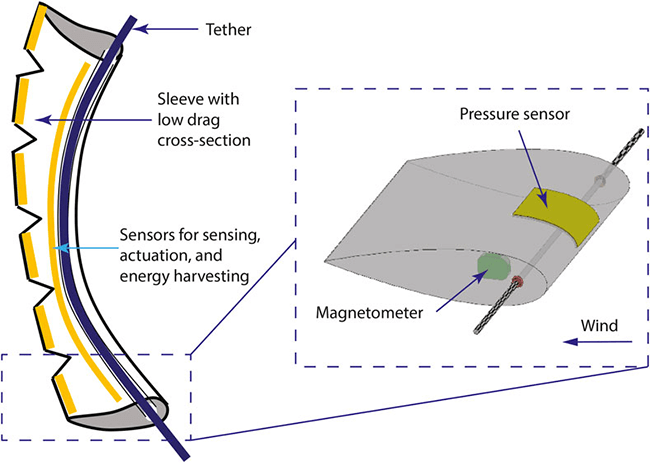Piezoelectric Anemometer Developed for Improved Plane & Drone Flights
| 11-08-2022 | By Robin Mitchell
Recently, researchers demonstrated an anemometer that utilises solid materials that help to significantly reduce drag while simultaneously reducing energy consumption and improving performance. What challenges does wind present to autonomous drone systems, what did the researchers demonstrate, and how does this illustrate the importance of solid-state devices?
What challenges does wind present to autonomous drone systems?
Drone technology has come exceptionally far in a very short amount of time, thanks to the advances made in microcontrollers, battery, and material technologies. One design, in particular, that has helped the drone industry is the quadcopter, as it allows for vertical take-off and stationary capabilities and is very adaptable in different conditions.
If combined with autonomous flight, a quadcopter can be made to follow a target at any speed and provide aerial coverage through live video feeds. Such a platform can also be configured to deliver packages to a predefined destination whereby an autonomous flight system navigates the drone to the destination, drop the cargo, and return to base. In fact, this has been done to some degree on Mars with the Ingenuity drone that is given waypoint instructions but decides how it should move instead of relying on a live feed of control data from Earth.
But even though autonomous flying systems have progressed, they still suffer from numerous challenges. One such challenge is recognising objects and deploying safe object avoidance routines, and another is the ability to see other drones reliably to avoid in-air collisions.
Wind, however, is one challenge that is not so easy to solve. A strong gust of wind can easily blow a drone off course significantly, making the safe operation of autonomous drones in windy conditions difficult. Trying to react to changes in wind in real-time can be difficult as onboard computers would be trying to correct the resulting movement caused by wind as opposed to understanding the current wind speed and direction and then making adjustments to counteract the wind before the drone is moved.
Detecting wind can be done using numerous technologies, which are often bulky and power-consuming. Anemometers typically consist of a small fan or sail that catches the wind and turns a dynamo, and the generated voltage corresponds to a wind speed. However, these anemometers are large and cause significant drag, which is problematic, to say the least.
Another detection method is the use of a hot wire placed in a chamber. The faster the airflow goes past the wire, the cooler the wire becomes, and this corresponds to a decrease in resistance. But while this has no moving parts, it still introduces drag and requires high currents to heat up the wire.
Researchers develop piezoelectric-based anemometer
Recently, researchers from The Ohio State University developed an anemometer that utilises piezoelectric elements to determine wind speed and direction, providing numerous advantages, including lower energy consumption and minimal aerodynamic drag. To create the new devices, the researchers turned their attention to polyvinylidene fluoride (PVDF), which is a piezoelectric polymer that not only provides sensing capabilities but is also self-powering.
When exposed to wind, the resulting compression creates a change in capacitance, while changes in wind speed and direction also cause changes in voltage (remember that piezoelectric elements produce a voltage under changes in deformation). After numerous tests, the researchers were able to show changes in capacitance that corresponded to changes in the wind with a mostly linear correlation (this is particularly advantageous as it eliminates the need for AI processing to isolate data).
But by far, the most important feature of the new sensor is that its low-profile size allows it to be mounted onto the surface of an aerofoil, and this minimises the drag effects of the sensor while providing the craft with wind sensing capabilities. Additionally, the use of integrated wind sensors into aerofoils also provides craft with the ability to confirm the condition of wings and detect sudden changes in the aerofoil.

The new sensor also provides advantages for non-winged drones. The small size and low-energy nature of the sensor make it ideal for miniature drones that are particularly vulnerable to the wind, and the ability to detect wind and safely react to sudden gusts makes using such drones near people safer.
Currently, the researchers are planning to perform more tests on their sensor as well as see how well it performs in a real-world application.
How does this demonstrate the importance of solid-state devices?
While the researchers didn’t refer to their device as a “solid-state” sensor, it certainly qualifies as one.
Solid-state devices provide a multitude of advantages over other sensing technologies, including lack of moving parts, longer lifespans, smaller sizes, and lower energy consumption. Of course, solid-state devices will often be more expensive (see SSD vs HDDs) and can sometimes come with technical challenges, but it is clear that engineers are slowly moving toward solid-state devices.
If the sensor developed by the researchers does indeed become a mainstream technology for detecting wind speed, it could help to improve the safety of drones and, in turn, help to bring about fully automated drones.

